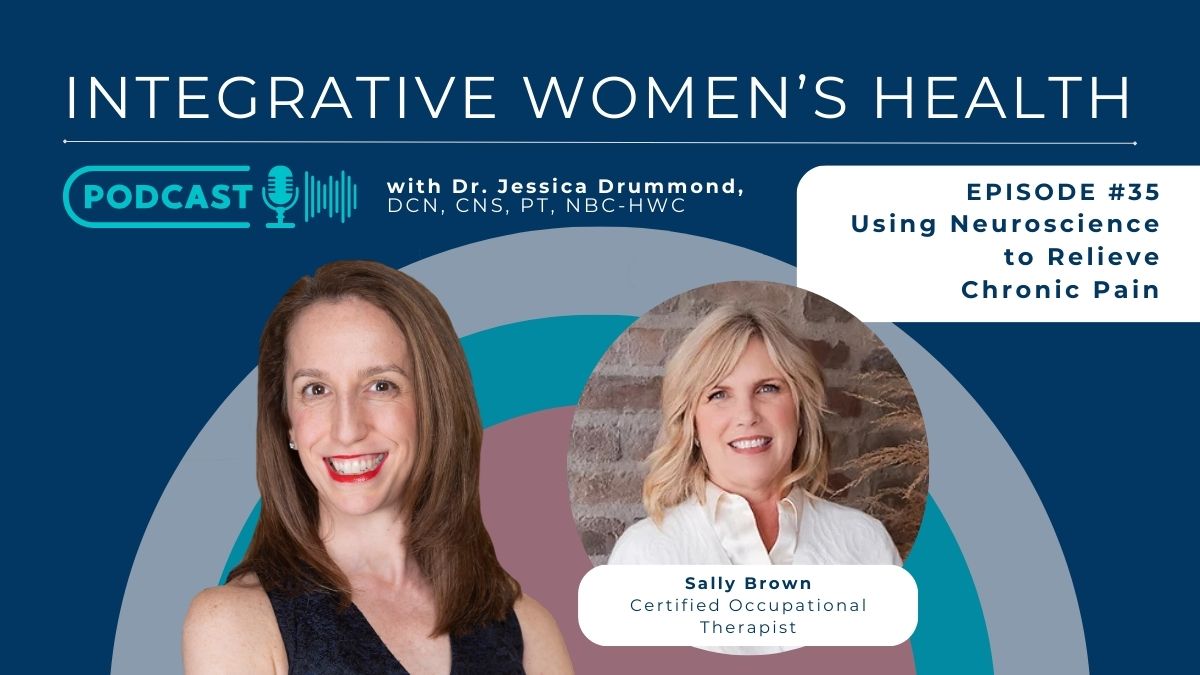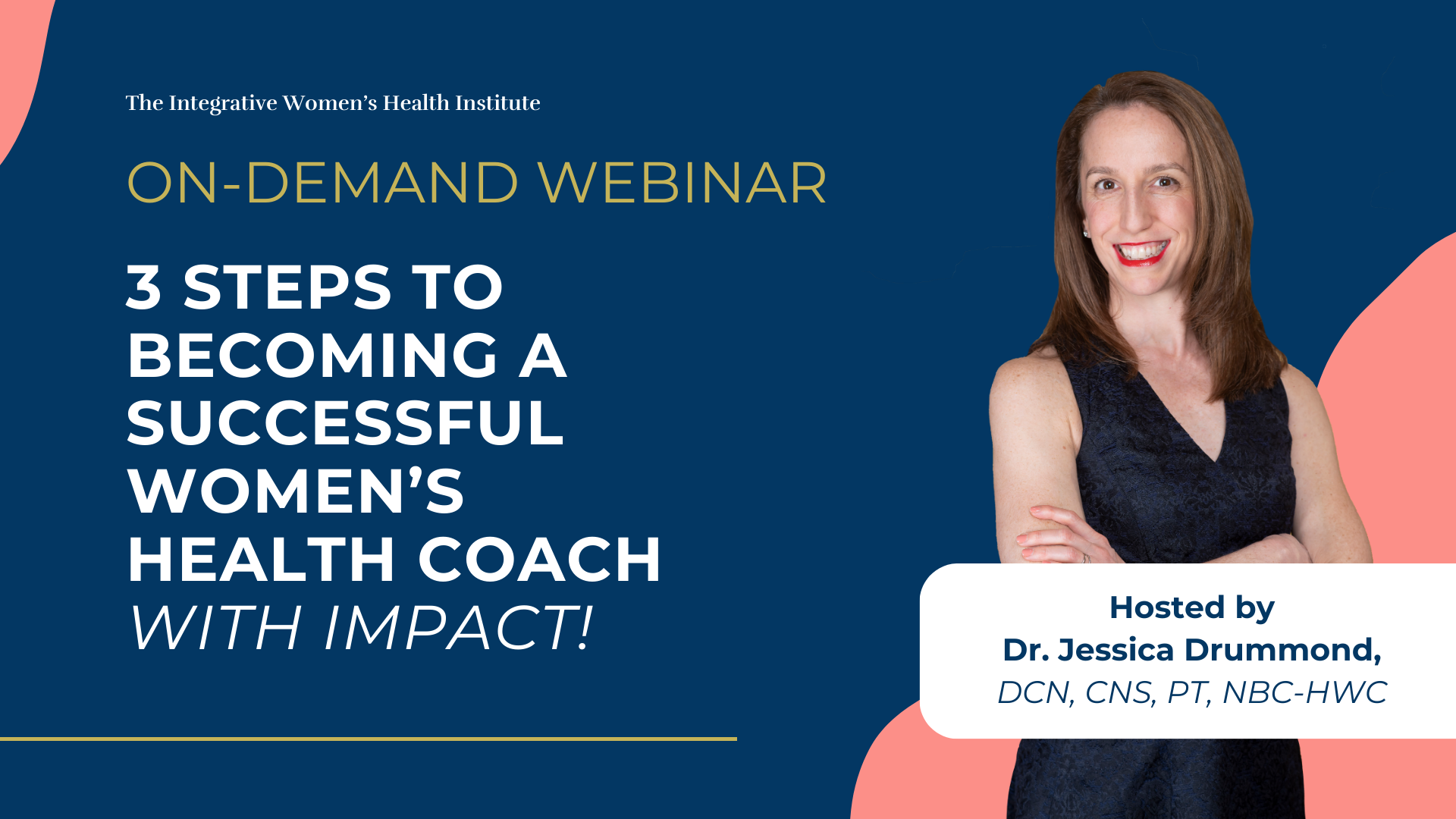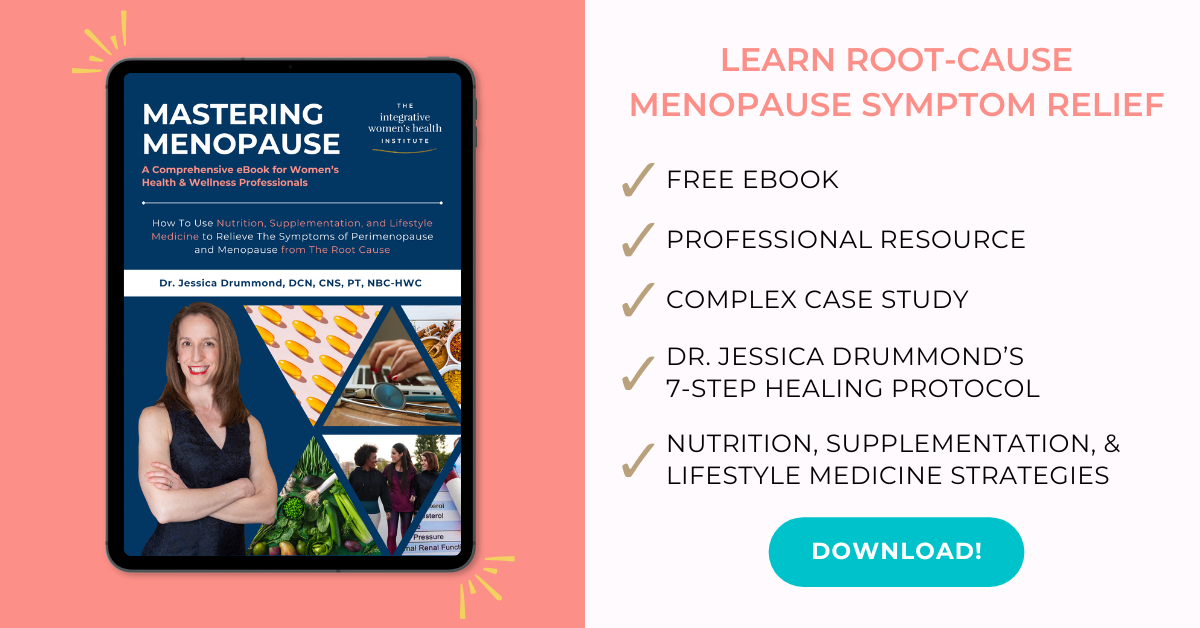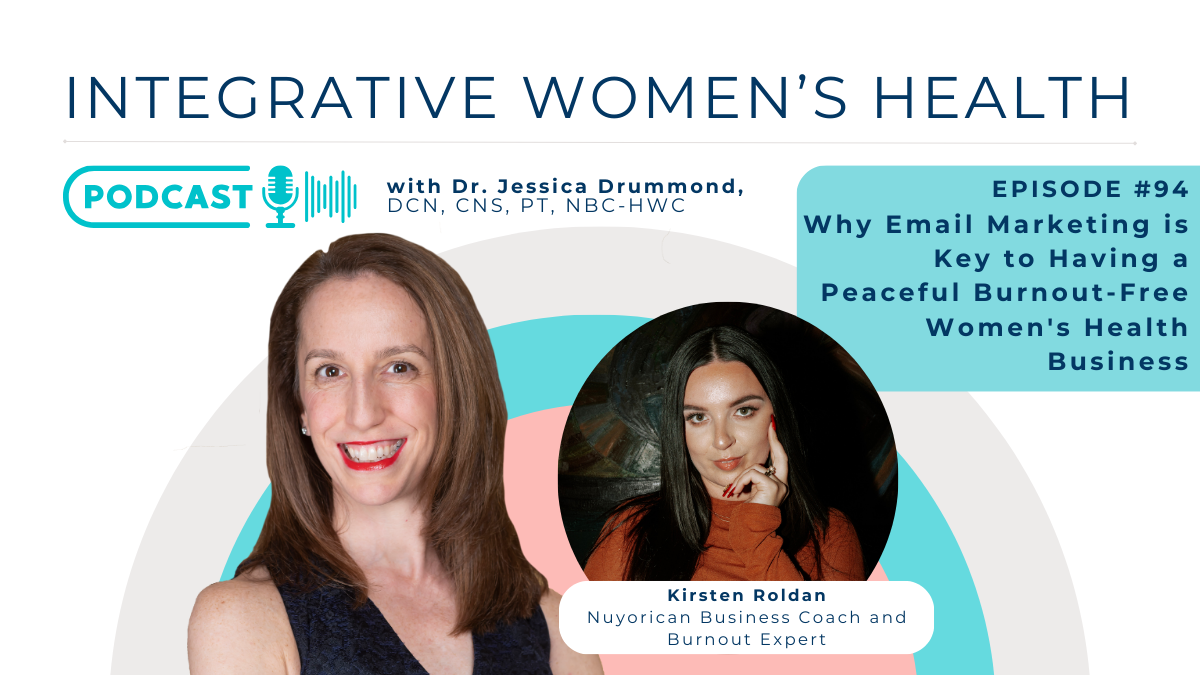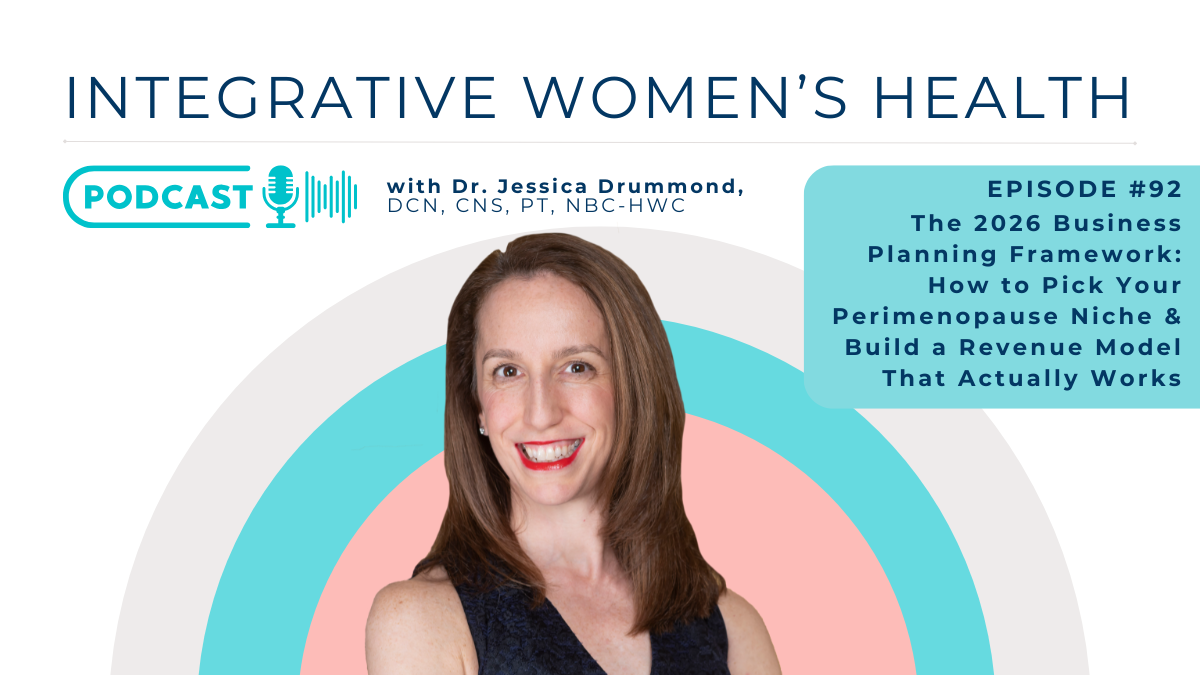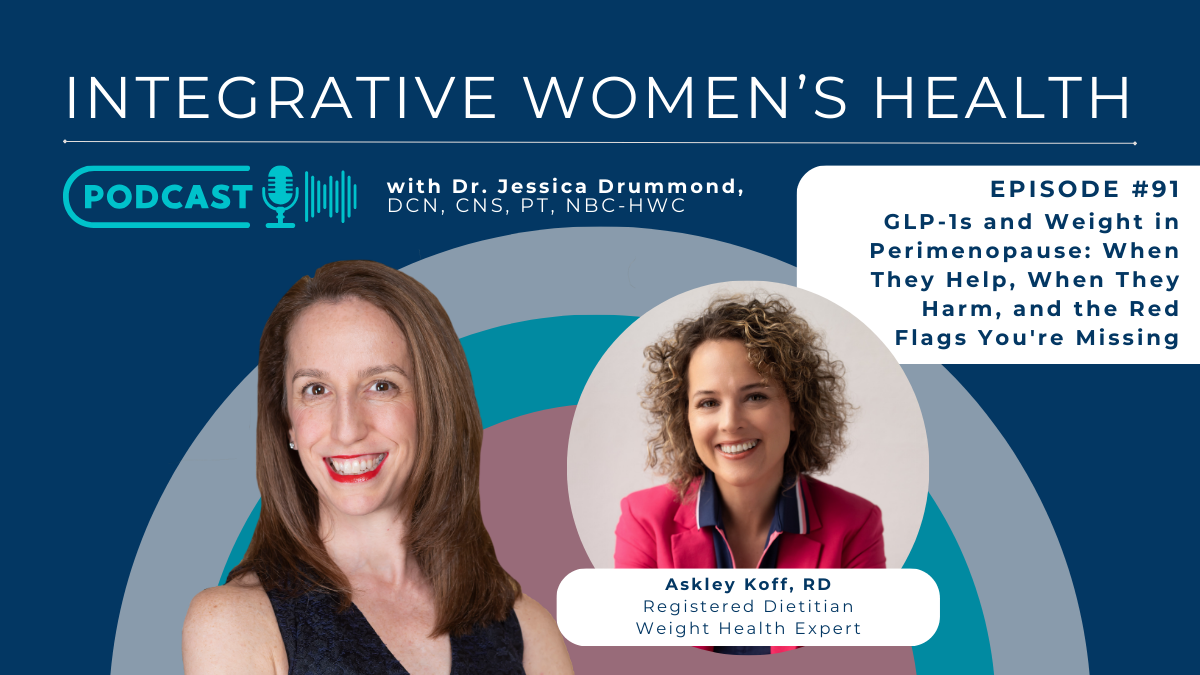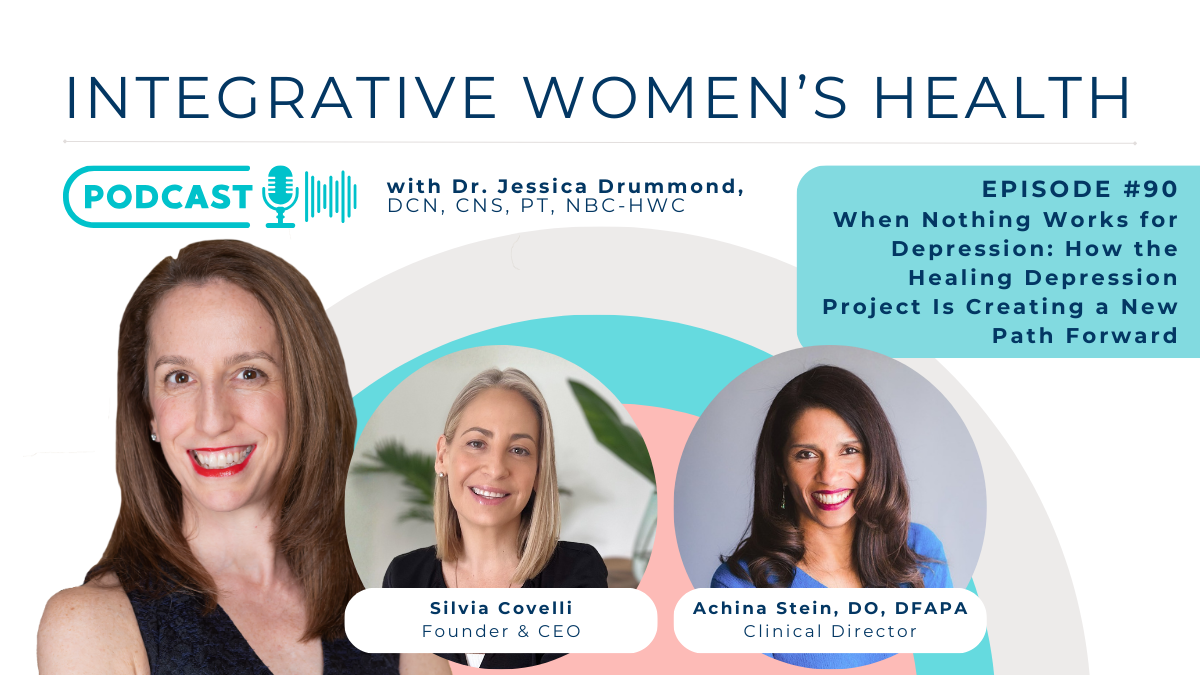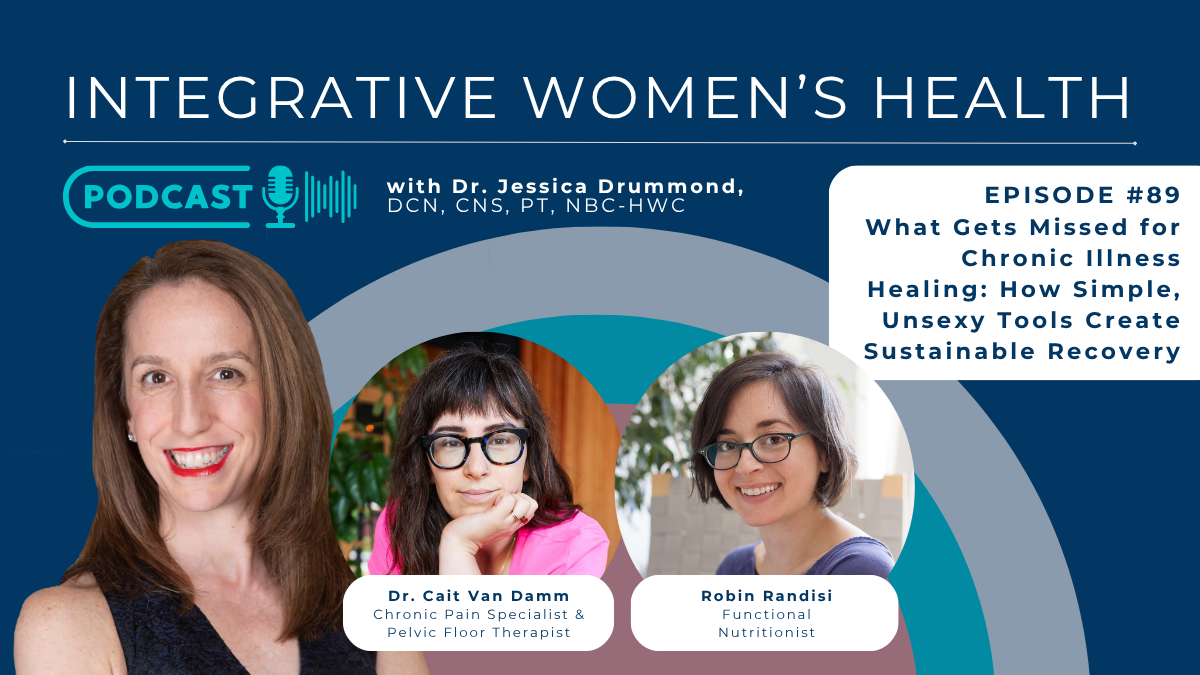Follow Us for Free:
About the episode
“Your brain has a lot to do with the way that pain is showing up in your life.” – Sally Brown
There’s a chronic pain epidemic among women in midlife, and it shows up in a lot of different ways, from stress to lack of sleep, and more. While there’s a lot we can do to have healthier hormone levels and more stress resilience, another element that can make a big difference is creating a daily practice using simple tools to rewire the nervous system.
Having a practice that you follow regularly, especially on days you’re not in pain, is as important as the tools themselves when it comes to supporting women with chronic pain or struggling with pain in the menopause transition.
Today, I’m excited to introduce you to Sally Brown, the co-founder of Women in Harmony. Sally and her co-founder, Charla Stilling-Hayes, are occupational therapists committed to educating and providing harmony within the transformation process of menopause that goes beyond managing symptoms.
In this conversation, Sally and I discuss how pain neuroscience education can empower women in midlife, what we need to understand about the nervous system’s role in pain perception, practical tools to incorporate into daily self-care practices, fostering resilience, and more.
Enjoy the episode, and let’s innovate and integrate together!
Highlights
- How pain neuroscience education empowers women in perimenopause
- Sally’s insights on the different experiences of pain among patients
- Understanding the relationship between the mind and the perception of pain
- The interconnectedness of stress and pain, particularly during menopause
- Binaural beats as a pain management tool
- What research shows about how binaural beats can reduce the need for anesthesia
- Calming techniques for pain relief
- How pain is processed in the brain
- The importance of understanding and managing pain
- Setting achievable goals in pain management
- Exploration of additional tools to help shift from a stressed
- Tools to visualize physiological responses
- Cognitive behavioral therapy for chronic pain
- Unique pain experiences in midlife
- The vicious cycle of pain and sleep
- The multiple responsibilities and stresses faced by women in midlife
- Simple techniques to manage stress and improve sleep and pain
- Daily self-care practices you can easily integrate into your life
- How better sleep and stress management contribute to pain control
- The prevalence of chronic pain issues in women experiencing hormonal changes
Connect with Sally Brown
Ready to revolutionize your career and grow your practice?
- What is the next step in your career? Click here: https://integrativewomenshealthinstitute.com/start-here/
- Integrative Women’s Health Institute on Instagram | @integrativewomenshealth
- Integrative Women’s Health Institute on YouTube
Learn more about The Integrative Women’s Health Institute’s Programs.
Click here for a full transcript of the episode.
Dr. Jessica Drummond 00:00:03 Hi and welcome to the Integrative Women’s Health Podcast. I’m your host, Doctor Jessica Drummond, and I am so thrilled to have you here as we dive into today’s episode. As always, innovating and integrating in the world of women’s health. And just as a reminder, the content in this podcast episode is no substitute for medical advice, diagnosis, or treatment from your medical or licensed health care team. While myself and many of my guests are licensed healthcare professionals, we are not your licensed healthcare professionals, so you want to get advice on your unique circumstances. Diagnostic recommendations treatment recommendations from your home medical team. Enjoy the episode. Let’s innovate and integrate together. Hi there. Welcome back to the Integrative Women’s Health Podcast. I’m your host, doctor Jessica Drummond, founder and CEO of the Integrative Women’s Health Institute. Today you are going to learn a few key tips that you’re going to want to write down. If you are a busy working woman in your 40s, 50s or 60s, maybe even your 30s. These are tools that we probably should learn in about seventh grade, but often we don’t learn until midlife.
Dr. Jessica Drummond 00:01:31 I can’t wait to introduce you to Sally Brown. She is the co-founder of women in Harmony with her partner, Karla Schilling Hayes. They are both occupational therapists. Sally is an occupational therapist and Carla is a occupational therapy assistant, and they have been working in clinical practice for more than 30 years specifically. Now they support women in midlife, at women and Harmony, women and harmony. Com who are struggling with chronic pain. And they do it in a way by really integrating all of the pain neuroscience research that we have from Stanford University and beyond. And you’re going to love this episode. I want you to listen carefully and take just one tip that you and your clients are going to start to practice. We’re going to talk about the importance of practice that you’re going to practice, even an especially on days you are not in pain or not feeling significant stress. The practice is as important as understanding the tools. So let’s get into this episode and I’ll see you on the other side with my favorite tip for moderating those days when your pain is extremely intense.
Dr. Jessica Drummond 00:03:01 Hi, everyone. Welcome back to the Integrative Women’s Health Podcast. I’m your host, doctor Jessica Drummond, founder and CEO of the Integrative Women’s Health Institute. And I can’t wait for you to meet Sally Brown. She and her colleague are the founders of women in Harmony, and we’re going to dive right in to talking about how pain neuroscience, and we talk about this a lot around here can really be an important tool for supporting women in perimenopause who are struggling with pain or who are struggling with chronic pain, and then make that transition into perimenopause. So, Sally, what got you interested in going deeper in your learning around pain neuroscience and then applying it to your clients as an occupational No therapist.
Sally Brown 00:03:54 So I’ve been an occupational therapist for 30 years. So, you know, as therapists, we deal with patients in pain all the time. So trying to find ways to help people feel empowered with their pain. It’s really interesting to me. So I’ve seen people who tend to be athletes who, you know, pain has been part of their life just because, you know, never excel at any skill as an athlete unless you’re experiencing some pain and you realize that the pain is going to go away.
Sally Brown 00:04:23 And then there’s different patients who maybe haven’t been as athletic in their lifetimes, and they feel like they get controlled by pain, that it’s now changing them. And you can see it when they come and sit in front of you and talk about their, you know, new life experiences and what’s going on when they’re trying to sleep or when they’re trying to, you know, function as a mom or function at work. And you just see the difference between the two types of people. And that’s where Stanford had come in and done a lot of research around pain neuroscience education. And I had learned about this certification for something called Empowered Relief. So I took that certification. And, you know, they gotten funding from the National Institute of Health to focus on pain neuroscience education because of what’s going on in our country with opioids. So, you know, we believed as a society for the most part, that if I give you a pill that’s going to control your pain and that’s the only way you can do it, there’s no other way.
Sally Brown 00:05:31 And you and I both know, gosh, there’s 6 million ways we can work on pain, but we’ve got heat, we’ve got exercise, we’ve got all these other ways of dealing with pain and then with pain. Neuroscience education came into play that your mind has a lot to say about how you’re going to experience pain. So just like when I was talking about those two different patients, the one patient feels that, you know, I have control over pain. I know that pain will end. I know that this isn’t going to control my life. And, you know, pain is a natural experience that is not threatening to us all the time. We can control it. And then there’s a different patient who that’s not the way that pain is showed up in their life. And, you know, this is now something that’s life changing and it’s never going to go away. And I’m going to catastrophize it, and I’m going to let it run my life instead of me having some control over it. And that’s the neat thing about the pain neuroscience education, is that it’s just about teaching people that their brain has a lot to do with the way that the pain is showing up in their life.
Sally Brown 00:06:36 And it’s, you know, these we’re talking about pain, but pain shows up as stress, and pain shows up as lack of sleep. And those are big things in menopause, right? Stress and lack of sleep are such contributors, and if you can control your pain, you’re going to be able to control your stress and be able to control your sleep better as well. So we’ve got a lot of things that we can do, like we were talking about.
Dr. Jessica Drummond 00:07:01 So yeah, absolutely. So essentially in your practice, you were seeing that there was a subcategory of your patients who, while they may have pain, they had a more relaxed relationship with it. Like, I’m an athlete, I’ve had pain before. I have some trust, some confidence that this pain will settle, will not be worse, will not be here forever, may completely go away. It wasn’t such a fear. There was less fear around pain. And then other people who maybe had experienced less pain in their life but now had a confusing diagnosis.
Dr. Jessica Drummond 00:07:40 Maybe the pain sort of felt like it came out of nowhere, or they had a major injury or a major illness, And now their perspective is that, oh, no, there’s a lot of fear around this pain is happening to me in a way that there’s no way that it’s ever going to get much better. So you thought, well, let me get more tools around how we can rewire that nervous systems response to pain, and what are some of the most valuable of those tools that help people make that pretty big mindset leap? If you know they’re 50, right? And now they’re in perimenopause, they’re stressed, they have an illness, they have an injury, they’re having sleep issues anyway because their progesterone is dropping. And it’s like, I’ve never had this before. And now like, am I going to have this the rest of my life? It could be really scary.
Sally Brown 00:08:35 Absolutely. Yeah. And then, you know, once you’re scared, your blood pressure is going up, you’re not going to be able to sleep.
Sally Brown 00:08:41 So it becomes this big cycle of pain, right? We’ve seen that in our practices where, you know, pain leads to weakness, which leads to more pain, which leads to stiffness and, you know, less sleep. And so everything becomes cyclical. And then those patients are like, oh, gosh, this is really changed my life a ton. And so, you know, maybe they’ve had some pelvic floor issues or something like that. That’s really changed the way, you know, pain is showing up in their life and it becomes something daily, something where like is this ever going to end like you just said, like that? I’m now catastrophizing this in my head and I’m saying, wow, this is my new normal. I don’t like any of this. This is absolutely terrible. So some ways that they can deal with that is I don’t know if you’ve heard of binaural beats.
Dr. Jessica Drummond 00:09:27 Yes. But go ahead and explain it. Yes.
Sally Brown 00:09:29 Yes okay. Sure. Yeah. So binaural beats is one way that you can take control of your nervous system.
Sally Brown 00:09:34 So by listening to some calming, meditative apps, Stanford has one very specific one that’s through Empowered Relief, which is what Charlotte and I teach. I give everybody this audio file afterwards. And so with binaural beats, the sound waves go in one ear and then in other ear, and they basically help you learn how to calm yourself so you can sleep better so you can have less pain. So you can deal with all of this new normal situation going on. So Stanford’s research also showed that it was pretty neat study. So let’s pretend there’s three groups of people in a room, and we’ve got one group of people over here are going to have some surgery, and we’re going to put some headphones on them before they have the surgery, and they are going to listen to the binaural beats. And then we’ve got a second group of people who are going to have surgery as well. But instead of listening to binaural beats, we’re going to have them listen to some music. And then the third group of people, we put the headphones on them, but we don’t have any audio file at all.
Sally Brown 00:10:38 There’s nothing happening. And so they found out that people who were are listening to the binaural beats actually require less anesthesia. Wow. Yeah, it’s really exciting. So there are several hospitals across the country who are now starting to use this prior to surgery and or are requiring patients to go to the empowered relief before they have surgery. So anyway, you know, for those people who are listening to us, you know, during anesthesia, your anesthesiologist doesn’t leave the room. Once he puts you under, he’s monitoring your heart rate and your respiratory rate, because that shows how much stress you’re under or how much pain you’re feeling. So for those people who are listening to the binaural beats, they require less surgery because their heart rate stayed lower and their respiratory rate stayed lower. So that’s how they know that it was working. So it’s really neat thing. I’m super excited about being able to offer that to my patients because it’s easy. You don’t have to learn anything new. You just put it on. I have these new sleep aid headphones that I can actually put on when I use this myself.
Sally Brown 00:11:42 So just I put them on in their soft and I can sleep with them. So if I’m getting ready for bed and I’m feeling like, gosh, I don’t know if I’m ready, I’m just not quite sure if I can sleep tonight. All of us have experienced changes in our sleep and I’ll put that on, and it really helps me just get relaxed and then I can easily fall asleep. So, you know, it’s not just for pain, it is for stress and for sleeping as well. So that’s one thing that is super interesting about the empowered relief and being able to give them a tool right away. Other ways of helping people understand this is talking about pain. Like how does pain show up in your body? Like, you know, you and I both know because we went to school for this, you know, oh, they have a spinal cord and then your brain is processed. The pain your your if your hand experiences pain, it doesn’t really mean that your hand is experiencing pain.
Sally Brown 00:12:34 Your brain is understanding that your hand is experiencing pain. And we know this because people who have had amputees, they still experience pain. So you don’t even need your limb to experience pain. Your brain is what’s processing it. So talking to them about oh, okay. So if I can calm myself in a way, you know, maybe some deep breaths, just getting the respiratory rate under control, then I can then distract my brain or essentially calm my brain so that I’m not. My pain isn’t showing up in such a huge way that I can’t function afterwards. And I’m saying, oh gosh, now I can’t do anything because I’m having pain. It’s like, well, if we can calm ourselves, you know, self-soothing things as well. So maybe you like to take baths. Maybe that’s something that if I go take a bath, oh my gosh, I’m so calm afterwards. And then I can, you know, deal with whatever pain is happening or whatever stress is happening. So helping them to come up with a personalized plan of what makes sense for them in their life.
Sally Brown 00:13:37 So, you know, if you’re at work, you obviously can’t take it back or that’s not going to work very well. But maybe you love tea. Maybe you just need to take a break and go make yourself some tea. You know, so having a list of things that they can look at. So if they’re feeling stressed or if they’re feeling pain, they can just pull that list out and go, okay, all right. I’ve made this list before because when we’re stressed we’re not very good problem solvers. Right. So if you’ve already got your list made for you, then you can figure it out. So those are some of the ways that, you know you can kind of deal with pain.
Dr. Jessica Drummond 00:14:11 Well, and I think this is so empowering because when we better understand pain that while obviously there’s some relationship to tissue damage or circulatory damage or organ damage, sometimes in a localized area, the nervous system is not always very accurate at pinpointing that localized area at pinpointing even actual tissue damage. So there could be tissue damage.
Dr. Jessica Drummond 00:14:41 There might not be. There could be an illness. There could be, you know, an infection in that area, but not always. So once people, I think, are educated in that way, it’s very empowering because that’s not something you might learn in seventh grade biology. Right. Like it’s more like if you have pain, it’s because you injured your hand or your brain or your hip or whatever. And so now understanding that sometimes pain takes some of those external information, but often the nervous system actually puts the pieces together and creates a message of pain that may or may not be very precise. And so once they know that, there’s sort of a sense of calm like, oh, this is real pain, because I think the biggest pitfall of this kind of work is the struggle with not saying to people your pain is quote unquote all in your head, but reminding or educating them that it actually is at some level, being at least partially generated by the nervous system. How do you toe that line so that people don’t get frustrated or defensive?
Sally Brown 00:15:57 Yeah, we absolutely talk about that that, you know, pain is real.
Sally Brown 00:16:00 All pain is real. The pain you’re experiencing now is absolutely real. It’s showing up in your brain. It is, you know, changing your nervous system. It’s making you have, you know, more increased heart rate, you know, increased respiratory rate. All of those things are very, very real. And so, you know, reassuring them also that they’re not alone. They’re not the first person that this has happened to. And there’s actually a whole group across the country, you know, people just experiencing pain. I mean, I don’t think anybody gets out of here without experiencing some kind of pain. You know, we’re all going to, you know, stub our toe and so on, but that you do, like you said, have control over this. You do have an ability to understand it, put it where it needs to be in your life. And, you know, being able to even observe it and say, you know, that I understand that that’s happening to me right now.
Sally Brown 00:16:54 But I also know that I have been without pain in my life. And what you know, I’m going to get back to that if I can deal with what’s happening right now. So even if I can cut my pain in half, I can accomplish more and then I can celebrate with myself. Okay, you know what I haven’t been able to wear, you know, tight pants because my abdomen has been really painful from my fibroids or what have you. But, you know, I was able to wear these pants and I haven’t worn in a while today, and I couldn’t wear them all day, but I wore them part of the day. So small celebrations and trying to just think about instead of, I’m sure you know, as a pet, you think about this all the time to where you know, okay, so your end goal is to go back to the gym to be a Olympic powerlifter. Well, you know, getting back to the gym with chronic pain is maybe not a goal today, but, you know, maybe you can do a walk down the street and, you know, just being able to get some endorphins going and then, you know, trying to not disappoint people who have, you know, big goals for themselves because we really want to live with, you know, okay, that is your goal.
Sally Brown 00:18:12 We’re going to get there. But we have to break it down into small, kind of manageable bites, doing the same thing with pain and talking about, okay, we’re not going to carry your pain today. We’re not going to, you know, make this all go away. But we’re going to give you some control over what’s happening so that, you know, you’re not feeling like this is all I have anymore is pain.
Dr. Jessica Drummond 00:18:36 Yeah. So really holding that space for possibility that this pain could experience some temporary completely relief today or a downtick in intensity, or it might move a little bit. And I love how you bring in that. Other things are going to impact the intensity and maybe the length of time that people are managing pain. And those include sleep and they’re generalized stressors or generalized stress response. So we have binaural beats. We have this wisdom that pain can, at least at some level, be generated from the nervous system, even if it’s taking into account some of the external signaling, which helps us to gain some empowered beliefs around pain, that it can be modulated by things that we do.
Dr. Jessica Drummond 00:19:36 We don’t just necessarily need a or even things that we think, or how we tense our muscles or how we relax versus, you know, needing medication or surgery in every case. What are some of the other tools that you might use to help people shift out of that kind of up regulated, stressed nervous system, especially if they’ve been in pain for a really long time to the level where it’s almost maybe part of their identity.
Sally Brown 00:20:07 Yeah, yeah. So back to the nervous system being the respiratory rate as well as your heart rate. So we can control those. I, you know, can’t say to you, Jessica, hey go ahead and lower your heart rate. But you can do that by deep breathing. So even I think you’ve talked about this. You know, when I took your classes, a box breathing. So an inhale and exhale, an inhale and exhale and just even taking a minute. Just sit down and breathe deep. Inhale and exhale and inhale and exhale and maybe seeing even a mantra to yourself, like in this moment I’m okay.
Sally Brown 00:20:49 In this moment I’m okay while you’re doing the deep breathing. So that allows you to then control your respiratory rate and your heart rate. And so when those come down, you’re going to automatically experience pain in a different way. So you’re going to take the edge off the pain just by doing a little deep breathing. Because when you have an increased respiratory rate or you have an increased heart rate, pain is going to be elevated and it’s going to show up in your muscles and your tension and the tightness like you were just mentioning. And that’s a nice easy.
Dr. Jessica Drummond 00:21:24 Yeah. And I love this these tools, the slow deep breathing, the binaural beats, the just awareness of how pain is experienced and how that can vary. But I think this is also so valuable because let’s imagine someone actually has an injury or illness that’s in the moment. Also driving the pain, whether it’s cancer or endometriosis or, you know, a major automobile accident or something like that. So they have pain driven from a particular driver within the periphery, not just in the brain, because we have this data from people undergoing surgery who are clearly being cut.
Dr. Jessica Drummond 00:22:06 Right? I always say, you know, surgery is kind of a knife fight. You were just sleep for it. So, you know.
Speaker 3 00:22:14 That’s good.
Dr. Jessica Drummond 00:22:17 And now we have these tools to visualize people’s heart rate, respiratory rate. And so as those physiologic responses are able to be modulated by the nervous system even when there is cancer, endometriosis, broken leg, whatever fibroids related pain, this stuff still works.
Sally Brown 00:22:43 Absolutely. You know, they looked at so with Stanford’s research, with empowered relief, they were able to compare it to eight weeks of cognitive behavioral therapy. So we now know that cognitive behavioral therapy has been super successful in helping people deal with chronic pain. So you know how it shows up in their lives. So the same they wanted to compress this because not everybody in the middle of, you know, Kansas has access to go get cognitive behavioral therapy, which is twice a week for eight weeks. So 16 times you’re going back and forth and maybe there’s nobody even nearby that you can even access.
Sally Brown 00:23:23 And so this is a portable way of being able to get it to them. And it’s a one time, two hour session that anybody across the country can access. So, you know, if this pain is showing up in your life because you’ve got cancer or you’ve got, you know, back to endometriosis, that’s really just disturbing you in a horrific way, then, you know, you can, do something about it with, you know, again, with the empowered relief and being able to take some control.
Dr. Jessica Drummond 00:23:53 Since you work primarily with women in perimenopause and menopause transition, what are some of the things you’re seeing in relationship to pain that are unique to this time in life?
Sally Brown 00:24:07 Yeah, I think for a lot of my patients, it’s showing up affecting their sleep. So, you know, they get so stressed during the day from the pain or from something happening. You know, even the vasomotor symptoms. You know, I’m uncomfortable to having vasomotor symptoms, right? So we’re going to call that pain because it’s making me uncomfortable.
Sally Brown 00:24:29 And so even though, you know, it’s something different than pain, it’s related to, you know, vasoconstriction. It’s showing up as uncomfortableness. So I get stressed from that. And then I can’t sleep. And then it becomes back to this vicious cycle. So now maybe I’ve got five hours of sleep at night and I know I’m supposed to get seven. And so that’s very distressing to me too. And so I’m showing up at work tired, and then it becomes all over again. I go back upstairs to get, you know, watch some television and then, oh my gosh, it’s already 9:00. I’m supposed to be getting ready to go to sleep and I’m wide awake. What is happening to me? So then I’m going to go lay down in bed, and then bed becomes something terrible because now I’m the bed is the enemy. I don’t want to lay down in bed. So now I’m kind of coming up with this whole scenario in my head of, gosh, this is absolutely terrible.
Sally Brown 00:25:24 And I’m laying in bed a wide awake, I don’t want to be here. If I toss and turn, I might bother my spouse. So now all of these negative thoughts have come up to me. And so, you know, back to this vicious cycle of uncomfortableness or pain and lack of sleep. That’s how most people are showing up for me, is just that it’s adding all up and it’s causing them, you know, mental anguish because they aren’t who they used to be. And that was why we came up with Harmony, because we wanted people to be able to feel like, you know, this is a true me. This is where I was when I was, you know, six year old girl running around and being able to do what I want to do and sleeping well after, you know, having a fun day. And that was what we were coming up with, with why we said Harmony.
Dr. Jessica Drummond 00:26:14 I really like that. What I love about these techniques is they’re so additive. You know, as you’re sleeping a little better, you can navigate stress better.
Dr. Jessica Drummond 00:26:25 And with that, through of the work that you’re doing, kind of reconnecting people back to the essence of themselves. What do you remember it feeling like when you’re a little kid and it’s summertime and you’re running around all day, and then you just climb into bed and fall asleep and you wake up and you may have a tussle, you might fall down, you might have a rough day, but you were able to move through it because there wasn’t all of these other layers of stress. By the time midlife women, you know, in our 40s and 50s, we’re dealing with issues with children, with work, with aging parents, with just the day to day stressors of having access to social media and chronic news. I like to call it chronic news.
Speaker 3 00:27:12 I think this is true.
Dr. Jessica Drummond 00:27:14 And so we don’t have that luxury of like the six year old clear brain to just fall into bed and go right to sleep.
Sally Brown 00:27:22 Yes, absolutely. Everything changed, right? There’s so much going on. You’re taking care of your kids.
Sally Brown 00:27:27 You’re taking care of your parents, taking care of the bills. You still have to work. It’s a lot. Just even not menopause, just getting, you know, that time of where we’re sandwiched generation, right? We’re taking care of the people above us and the people below us as our generations come together and trying to raise, you know, good humans. And in this environment of chronic news. Right. Yeah, it’s very stressful.
Dr. Jessica Drummond 00:27:54 And so any one of these techniques can kind of, you know, if you think of all those things as kind of stacked on top of midlife women’s shoulders, any one of these techniques can let it drift away a little because how we react and respond to those stressors also will impact our symptoms, our insomnia, our vasomotor symptoms. So if it all feels overwhelming, just the deep breathing or just the binaural beats or any of the other tools in the neuroscience toolkit, the five 28Hz music things that are free, readily available, nature, exposure for a few minutes.
Dr. Jessica Drummond 00:28:38 Mindfulness breaks that cycle of being like, this is terrible and this is terrible, and this is so difficult. And so I like that these tools are all so simple.
Sally Brown 00:28:50 Yeah, not all about self-care, right? We mentioned that word a lot out there in communities when we’re talking about self-care. This is true self-care that you don’t have to go get a manicure. You don’t have to go and get a massage. These are things that you can do that may take five minutes. You know, if you dedicate yourself especially you do it additively. So you say, okay, I’m going to commit to myself. I’m going to commit to taking care of myself. And so every day at lunch, I’m going to go outside and I’m going to walk in nature, like you mentioned, or every day I’m going to listen to those binaural beats because you can’t do self-care when you’re in the middle of a crisis. It’s too late. You need to do it additively. You need to say, you know what? I need to do something every day to calm my nervous system so that when stress does show up, because it’s gonna we’re, you know, here instead of starting from here.
Sally Brown 00:29:47 I love Adrian Lowe talks about that, that if we’re starting from a position of where we’re just barely managing our stress, if something else shows up, it’s going to be here. But if we can take our stress level down or pain level down, or manage our sleep or manage our vasomotor symptoms, and we’re starting from here on a daily basis. When things show up, it’s not going to be so horrible to us as being like, that’s okay, I can handle that. That is one more thing. All right, maybe I’m here, but I’m certainly not back up here, which is again, you have to manage it daily or it’s going to just add up.
Dr. Jessica Drummond 00:30:24 Absolutely. And so I think that recommendation essentially of daily practice, even the days you feel less stress, even the days you feel less pain or no pain at all, those are the days to practice, practice, practice. Because the lower that heart rate is, the higher the heart rate variability, the lower the breath, the respiratory rate on your resting days, then it’s less rattled on the more stressful days or moments.
Sally Brown 00:30:57 Absolutely. You know, that’s what Stanford again, back to its research talked about that that if you are just waiting until you are stressed to practice these things. They’re just not as effective. So if you’re going to be the most effective in retraining your brain to understand pain or to calm your nervous system when you aren’t very stressed. So that’s why it comes back to doing this as part of your self-care on a daily basis, almost like brushing your teeth. You’re going to commit to yourself that you know, okay, I’m going to just every night before I go to bed, I’m going to listen to that binaural beats. That’s an easy way to get it into your life. Or, you know, every day I’ve got to get outside, which is just great for you in general exercise. So maybe you go take that walk in nature where you’re outside. If you live in a place that’s safe and you know is nature, if you live in the middle of the city, might not be, you know your answer, but certainly, you know, doing all the other things.
Sally Brown 00:31:55 You can do something on a daily basis to calm your nervous system.
Dr. Jessica Drummond 00:32:00 Yeah. That’s lovely. Thank you so much for this education for these simple tools, for the reminder of the importance of daily practice, even when we’re not stressed. Anything else you want to share? Before we wrap up today about how people can use the the the pain neuroscience research that we have now to improve their chronic pain?
Sally Brown 00:32:23 I think we’ve talked about it, but just to recap, it’s not exactly just about pain. You know, it can be back about sleeping. If you can sleep better, you are going to control your pain better. If you have less stress, you’re going to control your pain better. If, like you mentioned before, if you are taking control of your deep breathing, you’re also going to set your heart but up for, you know, being able to handle stress better. So if we’re starting with a higher heart rate and then stress comes along, then we’re going to have a really high heart rate and then we’re going to, you know, have lots more problems.
Sally Brown 00:32:54 So being able to just manage yourself on a daily basis, you know, we are evolving creatures. We aren’t that six year old girl anymore. You know, our bodies got a couple more scars on it. And our hearts, you know, are different. You know that we’re we’re in our 50s, so stress will show up resilient, right? So we can’t expect our teeth to just clean themselves. And we can’t expect our nervous system just to take care of itself either. So we just need to, again, take care of them, take care of it on a daily basis.
Dr. Jessica Drummond 00:33:25 Yeah. And really building that resilience. And you’re right, it affects our cardiovascular health as well, which is so important in the 40s 50s and beyond. And for women, and especially since we are at high risk of arrhythmias. And so the more peaceful our resting state heart rate is, the better. So I love all of these tools and how wide reaching they are. Thank you so much for sharing this research and the work that you do and everyone.
Dr. Jessica Drummond 00:33:54 I recommend you go visit Sally and her team at women in Harmony. Where can we find you, Sally?
Sally Brown 00:34:04 Yes. At women in Harmony. Com so we are happy to have you visit our website. We’ve got some tips there. We also are on Facebook so we have a Facebook group. So if you’re just looking for some support for women who are aging that you can certainly join our group. And we try to send out, you know, Motivational Mondays and other tips for just dealing with life.
Dr. Jessica Drummond 00:34:26 Absolutely. I’m sure that’s well needed. I’m sure it’s a very popular group for sure. Thank you so much, Sally, for being here. And thank you everyone. We’ll see you next week. I hope you enjoyed meeting Sally and really sinking into the knowledge that you’re not alone. If you’re a woman in midlife, if you work with women in midlife, you know, but you also feel that there’s this chronic stress epidemic, that there’s this chronic pain epidemic. And some days when you’re not sleeping, when your estrogen is low, you may have.
Dr. Jessica Drummond 00:35:09 I had a client recently transitioned off hormonal birth control, and because she was perimenopausal and was trying to figure out what’s going on with her menstrual health and her hormone health, and out of nowhere, she had full body pain. Or you? I have another client who’s also in her late 40s, never used hormonal birth control or hormones, and all of a sudden she’s dealing with vaginal dryness, joint dryness, pelvic pain, back pain, frozen shoulder. So I think we don’t discuss enough the orthopedic impacts of hormonal related pain. And while there’s a lot we can do from a root cause standpoint in terms of optimizing the system to have healthier hormone levels and more stress resilience. A big piece of that is rewiring the nervous system, using some of these very simple tools that Stanford so brilliantly researched. So my favorite is well, first of all, I can’t emphasize enough what Sally said about daily consistent practice. Even on those days, you or your clients are feeling okay, feeling pretty good. Less stress, less pain.
Dr. Jessica Drummond 00:36:29 Had a decent night’s sleep. That’s when the practice is even more important. It’s like getting in the gym. You can’t just show up at the competition, right? You can’t just show up at the job interview and skip all the classes. You can’t just show up for the final exam and skip all the classes. You can’t just show up at the Olympics and not go to the training. Right? So this is the exact same thing. So the daily practice is what’s going to impact those days were the pain is very difficult, very intense. The stress levels are high and you don’t feel like you have a lot of support. That’s when I go to the easiest things, something that I don’t have to think about. I don’t have to try. My favorite is putting those headphones on, turning on the binaural beats. Or I also use and I mentioned in this episode, five 28Hz music, which is known to calm cortisol levels, putting on the headphones, not trying to do the breath work, not even having to leave the house.
Dr. Jessica Drummond 00:37:30 Just put on this music that even if you’re literally under anesthesia, knocked out in the midst of having surgery, will shift. And that’s pretty stressful, right? You’re unconscious. It’s very stressful, will shift your heart rate, your heart rate variability, and your breath rate. So breathing rate. So let’s start with that. Put on some headphones. Make sure somewhere on your phone you’ve got a little audio file, or a YouTube link, or a Spotify link where you are hearing you have the quick access to here. Five 28Hz music or binaural beats have that easily accessible practice it on the days you feel fine, and use it on the hardest days to just shift the nervous system to be less reactive to the pain. Thanks so much for joining us. Absolutely. Go follow Sally and her team, women and harmony.com and join their Facebook group to get support during this challenging time. And I’ll see you right back here next week. Thank you so much for joining me today for this episode of the Integrative Women’s Health Podcast. Please share this episode with a colleague and if you loved it, hit that subscribe or follow button on your favorite podcast streaming service so that we can do even more to make this podcast better for you and your clients. Let’s innovate and integrate in the world of women’s health.
Join Dr. Jessica Drummond to learn the three key steps to becoming a successful, board-certified Women’s Health Coach who leaves a lasting positive impact on their clients.
Learn how utilizing health coaching skills in your practice is crucial to your success, leaving a lasting impact on your clients, and shifting the paradigm of women’s healthcare.

Dr. Jessica Drummond
Founder & CEO
The Integrative Women’s Health Institute
At the Integrative Women’s Health Institute, we’ve dedicated 17 years to crafting evidence-driven, cutting-edge programs that empower practitioners like you to address the complexities of women’s health.
Dr. Jessica Drummond’s unique approach focuses on functional nutrition, lifestyle medicine, movement therapies, nervous system dysregulation, trauma, and mindset – essential elements often overlooked in traditional health education.
In addition, your training will be fully evidence based, personalized, and nuanced (this is not a cookie cutter approach) in functional nutrition, exercise, recovery, cellular health, and all other lifestyle medicine tools.
You’ll learn to support your clients with cutting edge tools safely and effectively.

